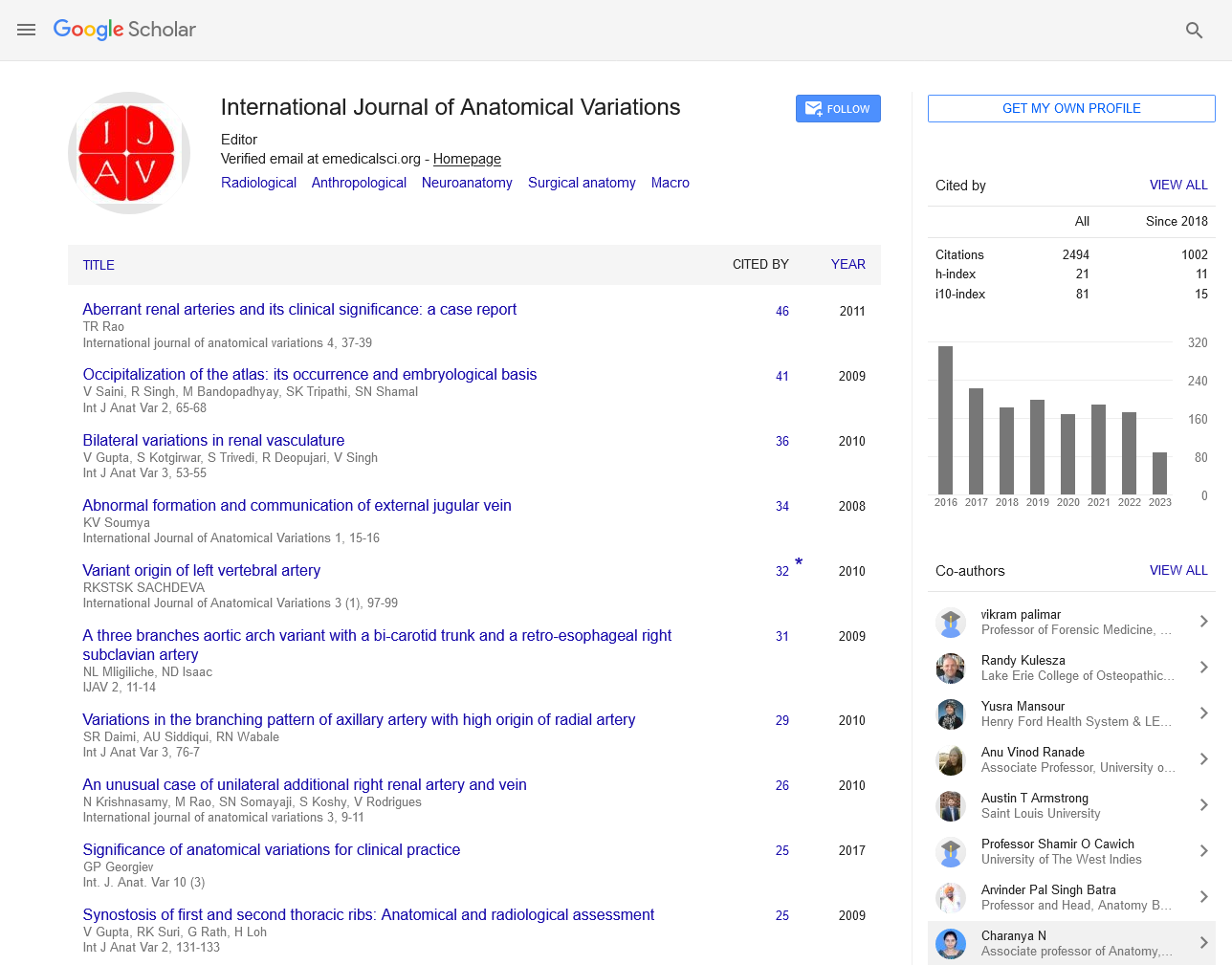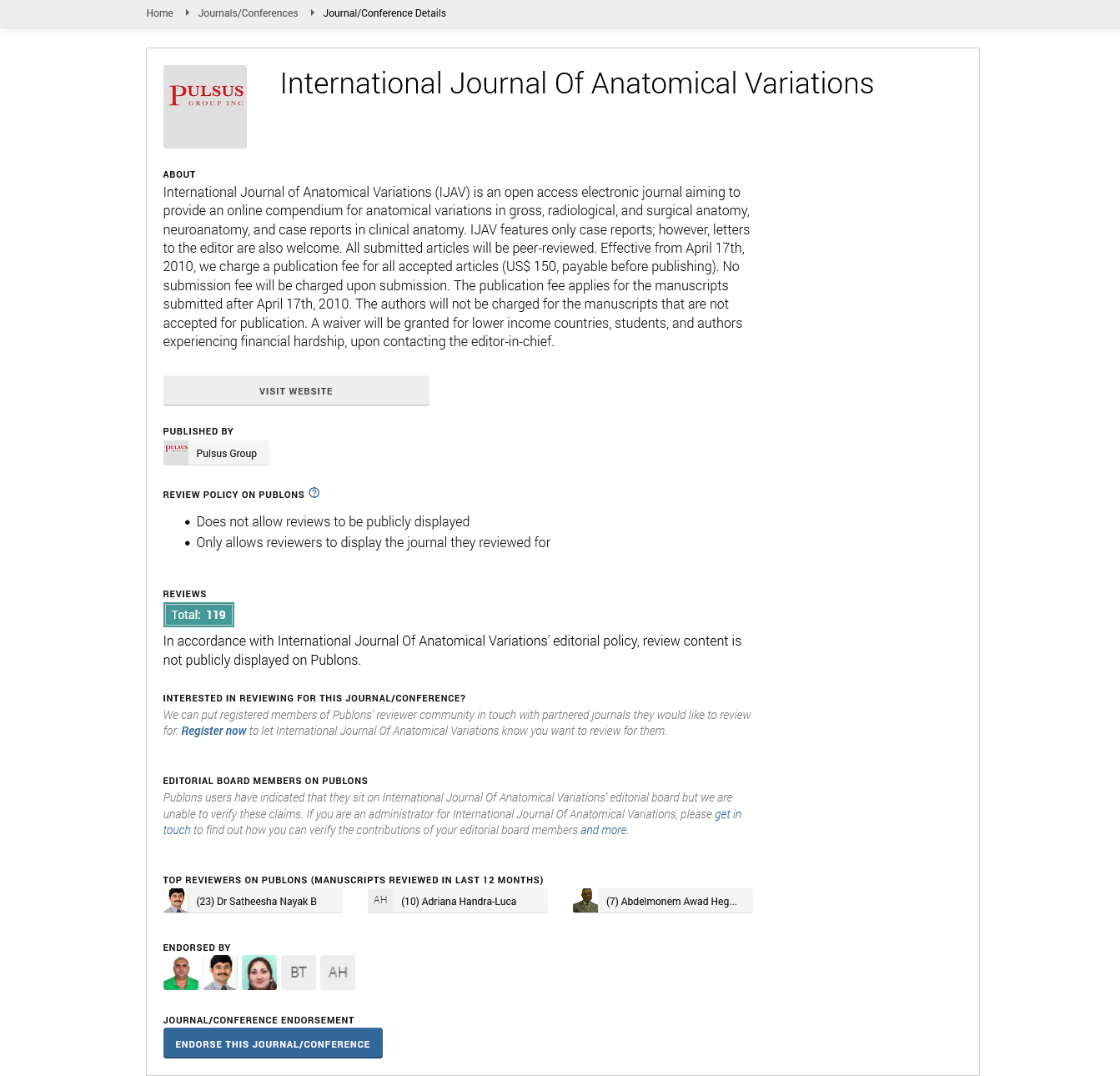A Comprehensive Review of Common Anatomical Variations in the Human Body and Their Clinical Significance
Received: 01-Mar-2025, Manuscript No. ijav-25-7642; Editor assigned: 04-Mar-2025, Pre QC No. ijav-25-7642 (PQ); Reviewed: 19-Mar-2025 QC No. ijav-25-7642; Revised: 26-Mar-2025, Manuscript No. ijav-25-7642 (R); Published: 30-Mar-2025, DOI: 10.37532/1308 4038.18(3).500
Citation: Sahu A. A Comprehensive Review of Common Anatomical Variations in the Human Body and Their Clinical Significance. Int J Anat Var. 2025; 18(3): 769-770.
This open-access article is distributed under the terms of the Creative Commons Attribution Non-Commercial License (CC BY-NC) (http://creativecommons.org/licenses/by-nc/4.0/), which permits reuse, distribution and reproduction of the article, provided that the original work is properly cited and the reuse is restricted to noncommercial purposes. For commercial reuse, contact reprints@pulsus.com
Abstract
Anatomical variations represent deviations from the typical anatomical structure without necessarily implying pathology. This review presents an overview of the most commonly encountered anatomical variations across multiple systems in the human body and discusses their embryological basis, prevalence, and clinical importance in surgical and diagnostic contexts.
INTRODUCTION
The standard human anatomy is widely studied and forms the cornerstone of medical education. However, real-world anatomical presentations often differ from textbook descriptions [1]. These differences—termed anatomical variations—are not anomalies but natural deviations. While often clinically silent, they can have significant implications in medical procedures such as surgeries, catheterizations, and diagnostic imaging. This paper explores commonly documented variations and highlights their relevance in clinical settings. Anatomy forms the foundational framework upon which all medical sciences are built. The human body, while classically described with standard anatomical templates [2], frequently presents with natural deviations from these norms—referred to as anatomical variations. These variations are not congenital anomalies or pathologies, but rather normal morphological differences that occur during embryological development and persist into adulthood. While many of these deviations are clinically silent and go unnoticed, some can have profound implications in diagnosis, treatment planning, and surgical outcomes. The significance of anatomical variations lies in their potential to alter clinical presentations and complicate both diagnostic procedures and surgical interventions. For instance, an atypical branching pattern of the aortic arch, an accessory renal artery, or a bifid median nerve can pose considerable challenges during cardiovascular, urological, or orthopedic procedures, respectively. In certain cases, these variations may even mimic pathological conditions, leading to misdiagnosis or inappropriate management. Despite their frequency, anatomical variations are often underrepresented in medical curricula and clinical practice guidelines [3]. A comprehensive understanding of these variations is essential not only for anatomists but also for clinicians, surgeons, radiologists, and other healthcare professionals who must navigate human anatomy with precision and adaptability. This review aims to provide a consolidated overview of the most commonly encountered anatomical variations across multiple body systems, examining their embryological origins, prevalence in the population, and clinical relevance. By shedding light on these variations, the paper seeks to emphasize the importance of anatomical awareness in enhancing patient safety, improving surgical outcomes, and fostering a more individualized approach to clinical care [4].
MATERIALS AND METHODS
A thorough literature review was conducted using databases such as PubMed, Scopus, and Google Scholar for studies published between 1990 and 2024. Keywords included “anatomical variation,” “clinical anatomy,” “surgical relevance,” and “embryology of anatomical variants.” Studies were filtered for relevance, methodological rigor, and clinical applicability [5].
ARTERIAL VARIATIONS
Arterial variations are among the most frequently encountered anatomical deviations and hold critical significance in both diagnostic imaging and surgical interventions. These variations arise primarily due to alterations in the embryological development of the vascular system, specifically the persistence, regression, or abnormal remodeling of embryonic arterial arches and their branches. One of the most commonly observed arterial variations is the presence of accessory renal arteries, which are found in approximately 25–30% of individuals. These additional arteries, often arising directly from the abdominal aorta, may supply the superior or inferior poles of the kidney and can pose challenges during renal transplantation or nephrectomy procedures. Another clinically relevant variation is the aberrant right subclavian artery, which occurs in about 0.5–2% of the population and may lead to dysphagia lusoria due to esophageal compression. In the upper limb, variations in the branching pattern of the brachial artery, such as a high bifurcation into radial and ulnar arteries, can affect blood flow assessment and complicate vascular access. Additionally, the persistent median artery, a fetal vessel that usually regresses, is present in up to 26% of individuals and is often encountered during carpal tunnel release surgeries, where its injury may lead to unexpected bleeding or postoperative complications. In the cerebral circulation, variations in the Circle of Willis, such as hypoplasia or absence of the posterior communicating arteries, are commonly observed and can influence collateral circulation during cerebrovascular events. Recognizing and understanding these arterial variants is crucial for minimizing iatrogenic injury, ensuring accurate radiological interpretations, and tailoring surgical approaches to individual anatomical profiles.
DISCUSSION
Recognizing anatomical variations is crucial for reducing surgical complications, improving diagnostic accuracy, and refining interventional techniques. Embryological origins often explain these variations, arising from disrupted or altered development of tissues.
CONCLUSION
Anatomical variations are common and medically significant. Continued research, documentation, and teaching are essential to adapt clinical practices to individual anatomical differences
REFERENCES
- Szymczak M, Krupa P, Oszkinis G, Majchrzycki M. Gait pattern in patients with peripheral artery disease. BMC Geriatrics. 2018; 18:52.
- Nayak SB, Shetty P, Surendran S, Shetty SD. Duplication of Inferior Gluteal Artery and Course of Superior Gluteal Artery Through the Lumbosacral Trunk. OJHAS. 2017; 16.
- Patel SD, Perera A, Law N, Mandumula S. A novel approach to the management of a ruptured Type II endoleak following endovascular repair of an internal iliac artery aneurysm. Br J Radiol. 2011; 84(1008):e240-2.
- Rayt HS, Bown MJ, Lambert KV. Buttock claudication and erectile dysfunction after internal iliac artery embolization in patients prior to endovascular aortic aneurysm repair. Cardiovasc Intervent Radiol. 2008; 31(4):728-34.
- Fontana F, Coppola A, Ferrario L. Internal Iliac Artery Embolization within EVAR Procedure: Safety, Feasibility, and Outcome. J Clin Med. 2022; 11(24):73-99.
Indexed at, Google Scholar, Crossref
Indexed at, Google Scholar, Crossref
Indexed at, Google Scholar, Crossref






